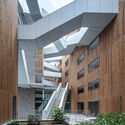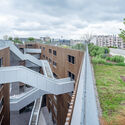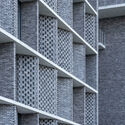
-
Architects: Atelier FCJZ, Coldefy
- Area: 8287 m²
- Year: 2023
-
Photographs:Fangfang Tian
-
Structure Design: AEDIS Ingénierie, AEDIS

the text provided by Atelier FCJZ
A permanent exposition of architecture - This project is located in the Cité Internationale Universitaire de Paris (CIUP) in the 14th Arrondissement of Paris. The university city was established to provide housing primarily to international students in Paris in 1925 and has now more than 40 dormitory buildings named after different countries. It is well known for its remarkable collection of architecture, such as the ‘Collège Néerlandais’ (The Netherlands College,1926) designed by Willem M. Dudok, the ‘Pavilion Suisse’ (The Pavilion of Switzerland, 1930) by Le Corbusier, the ‘Maison du Brésil’ (Home of Brazil,1954) by Lucio Costa and Le Corbusier, and the ‘Pavilion de L’Iran’ (Pavilion of Iran,1969) by Claude Parent.










































